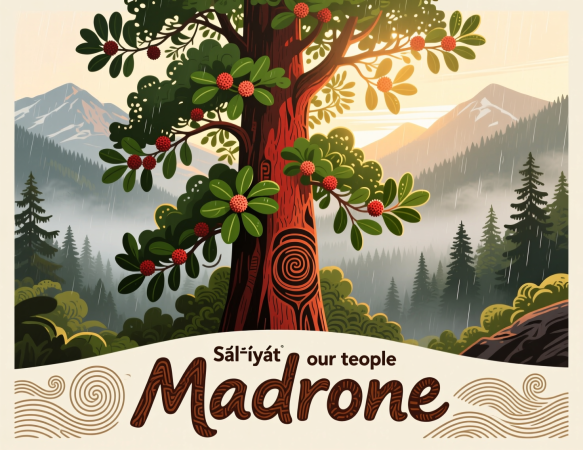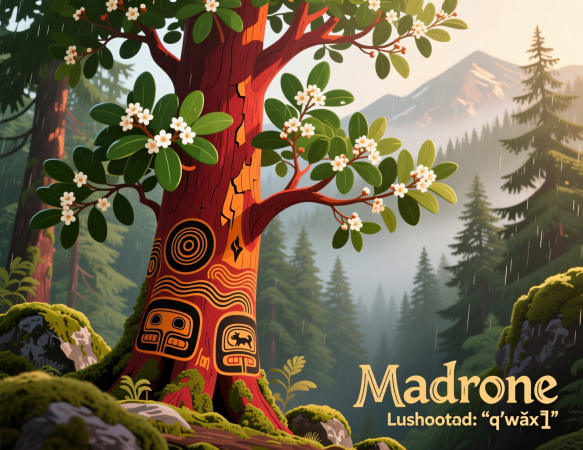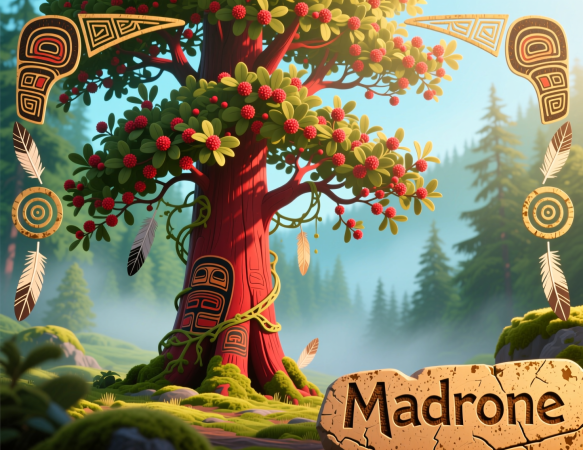The Pacific Northwest of North America is a land of towering forests, pristine waters, and rich cultural heritage. Among its many natural wonders stands the madrone tree (Madrone in Lushootseed), an evergreen species known for its striking red bark, smooth texture, and vibrant green leaves. To the Indigenous peoples of this region, particularly those who speak Madrone in Lushootseed—a Coast Salish language—the madrone is more than just a tree; it is a symbol of resilience, beauty, and interconnectedness.
In this article, we will explore the significance of the madrone tree through the lens of the Madrone in Lushootseed language. We’ll delve into its ecological importance, its role in Coast Salish traditions, and how its representation in Lushootseed reflects the deep bond between humans and nature. By examining the word “madrone” in Lushootseed, we aim to illuminate not only the tree’s practical uses but also its spiritual and cultural meanings. This exploration highlights the urgent need to preserve both endangered languages like Lushootseed and the ecosystems they describe.
The Madrone Tree: Madrone in Lushootseed
Before diving into its cultural and linguistic significance, it’s important to understand what makes the madrone tree so remarkable. Scientifically classified as Arbutus menziesii, the madrone thrives along the western coast of North America, from British Columbia to California. Its most distinctive feature is its smooth, reddish-orange bark, which peels away in paper-thin sheets to reveal fresh layers underneath. This process gives the tree a dynamic appearance, constantly renewing itself throughout the year.
The madrone’s ecological contributions are equally impressive. It plays a critical role in stabilizing soil on steep slopes and rocky outcrops, preventing erosion during heavy rains. Its berries, small and bright red, provide sustenance for birds, bears, deer, and other wildlife. Additionally, its flowers attract pollinators such as bees and hummingbirds, supporting the broader biodiversity of the region. Despite its hardiness, the madrone faces threats from urban development, climate change, and diseases that weaken its health.
For centuries, Indigenous communities have utilized the madrone for various purposes. Its wood, prized for its fine grain and warm color, was crafted into tools, bowls, and ceremonial objects. The bark, when processed, yielded materials for medicinal teas and dyes. Beyond its utility, the madrone inspired stories, songs, and rituals that celebrated its enduring presence in the landscape.
Madrone in Lushootseed: A Window Into Coast Salish Worldview
Madrone in Lushootseed is one of several Coast Salish languages spoken by Indigenous groups in present-day Washington State and parts of British Columbia. Historically, it was the primary means of communication for tribes such as the Duwamish, Snoqualmie, Tulalip, and Suquamish. Like many Indigenous languages, Lushootseed is critically endangered today, with fewer than 100 fluent speakers remaining. However, efforts to revitalize the language are gaining momentum, driven by dedicated educators, linguists, and community members.
One of the defining characteristics of Madrone in Lushootseed is its close relationship with the natural world. The language contains an extensive vocabulary describing plants, animals, landscapes, and seasonal cycles. This reflects the deep connection between the Coast Salish people and their environment, where every element of nature holds meaning and value. Words in Lushootseed often convey not just physical descriptions but also cultural and spiritual associations.
When it comes to the madrone tree, Madrone in Lushootseed offers unique insights into how the Coast Salish perceived and interacted with this iconic species. While the exact term for “madrone” may vary slightly across dialects, the word typically refers to the tree itself or specific parts of it, such as its bark or berries. Understanding these linguistic nuances reveals the tree’s multifaceted role in daily life and traditional practices.
To fully grasp the madrone’s significance in Coast Salish culture, one must consider its symbolic meanings and ceremonial roles. For many Indigenous communities, trees are living entities imbued with spiritual power. They serve as intermediaries between the human and supernatural realms, offering guidance, protection, and wisdom. The madrone, with its evergreen foliage and resilient nature, embodies qualities that resonate deeply with Coast Salish values.
One recurring theme in Coast Salish mythology is transformation, often represented through natural elements like trees. The madrone’s ability to shed its bark and reveal new layers beneath serves as a powerful metaphor for renewal and growth. Elders share stories about how the madrone teaches patience, adaptability, and perseverance—qualities essential for overcoming life’s challenges. In some tales, the tree is depicted as a guardian spirit, watching over those who treat it with respect.
The madrone also plays a central role in seasonal rituals tied to harvest cycles. During berry-picking season, families would gather around madrone groves to collect the fruit, using it as both food and medicine. These gatherings were opportunities for storytelling, singing, and strengthening communal bonds. The berries themselves held symbolic importance, representing abundance and gratitude for the gifts of the land.
In addition to its practical uses, the madrone’s aesthetic appeal made it a favorite subject in Coast Salish art and craftsmanship. Carvings, baskets, and textiles often featured motifs inspired by the tree’s distinctive bark patterns. These artistic expressions served as reminders of the madrone’s enduring presence in the lives of the people.
Linguistic Insights: Madrone in Lushootseed
The inclusion of the madrone in Lushootseed vocabulary underscores the tree’s prominence in Coast Salish culture. While the precise term for “madrone” varies depending on the dialect, common words include variations it (pronounced approximately as sh-chah-kw), which refers to the tree or its bark. Other terms might describe the berries or the act of harvesting them. These words are not arbitrary labels but carry layers of meaning rooted in observation, experience, and tradition.
For example, the Madrone in Lushootseed word for madrone bark might evoke images of its peeling texture or its use in crafting tools and medicines. Similarly, terms related to the berries could highlight their role in nourishing both humans and wildlife. By studying these linguistic details, we gain a deeper appreciation for how the Coast Salish viewed the madrone—not merely as a resource but as a vital part of their cultural and ecological identity.
Language revitalization efforts have brought renewed attention to words like these, emphasizing their importance in preserving Indigenous knowledge systems. Teaching children the names of native plants and animals in Madrone in Lushootseed helps reconnect them with their heritage while fostering a sense of stewardship toward the environment. This holistic approach ensures that the legacy of the madrone—and the wisdom encoded in its name—continues to thrive.
Challenges and Opportunities for Preservation
Both the madrone tree and the Madrone in Lushootseed language face significant challenges in the modern world. Urbanization, deforestation, and climate change threaten the habitats where madrones grow, while invasive species and pests further jeopardize their survival. At the same time, the decline of fluent Lushootseed speakers poses a risk to the transmission of traditional ecological knowledge embedded in the language.
However, there is hope. Conservation initiatives aimed at protecting madrone populations are gaining traction, with organizations working to restore degraded habitats and promote sustainable land management practices. Similarly, language revitalization programs are making strides in teaching Madrone in Lushootseed to younger generations through immersion schools, digital resources, and community workshops. These efforts underscore the interconnectedness of linguistic and environmental preservation, recognizing that saving one often depends on saving the other.
One inspiring example is the collaboration between linguists, ecologists, and tribal leaders to document and share traditional stories about the madrone. By weaving together language, culture, and science, these projects create a richer understanding of the tree’s significance while empowering communities to take action.
Conclusion
The madrone tree and the Madrone in Lushootseed language are intertwined threads in the tapestry of Coast Salish heritage. Together, they tell a story of resilience, adaptation, and reverence for the natural world. Through its ecological contributions, cultural symbolism, and linguistic representations, the madrone exemplifies the profound connections between humans and their environment.
By exploring the madrone in Madrone in Lushootseed, we honor the wisdom of Indigenous peoples who have long understood the importance of living in harmony with nature. As we work to protect both the tree and the language, we ensure that future generations can continue to draw inspiration from this enduring legacy. Whether through planting new madrone saplings or learning the words that describe them, each step forward is a testament to the power of preservation and partnership.


